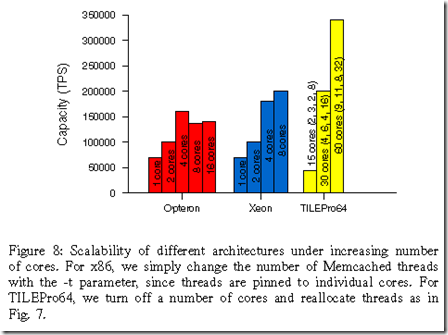There is a bunch of news on Facebook publishing results on the Tilera Server.
Facebook study shows Tilera processors are four times more energy efficient
Facebook sides with Tilera in the server architecture debate
Facebook: Tilera chips more energy efficient than x86
What I found as most useful is the PDF of the paper that Facebook published.
Many-Core Key-Value Store
Mateusz Berezecki
mateuszb@fb.com
Eitan Frachtenberg
etc@fb.com
Mike Paleczny
mpal@fb.com
Kenneth Steele
Tilera
ken@tilera.comWe show that the throughput, response time, and power
consumption of a high-core-count processor operating at a low
clock rate and very low power consumption can perform well
when compared to a platform using faster but fewer commodity
cores. Specific measurements are made for a key-value store,
Memcached, using a variety of systems based on three different
processors: the 4-core Intel Xeon L5520, 8-core AMD Opteron
6128 HE, and 64-core Tilera TILEPro64.
Here is the comparison of the Tilera, AMD, and Intel.
Here is a good tip and reason to think about more than 64 GB of RAM per server for memcache services.
As a comparison basis, we could populate the x86-based
servers with many more DIMMs (up to a theoretical 384GB
in the Opteron’s case, or twice that if using 16GB DIMMs).
But there are two operational limitations that render this
choice impractical. First, the throughput requirement of the
server grows with the amount of data and can easily exceed
the processor or network interface capacity in a single
commodity server. Second, placing this much data in a single
server is risky: all servers fail eventually, and rebuilding the
KV store for so much data, key by key, is prohibitively
slow. So in practice, we rarely place much more than 64GB
of table data in a single failure domain. (In the S2Q case,
CPUs, RAM, BMC, and NICs are independent at the 32GB
level; motherboard are independent and hot-swappable at the
64GB level; and only the PSU is shared among 128GB worth
of data.)
But, if you want to go beyond 64 GB, here are some numbers for a 256 GB RAM configuration.
And Conclusions.
Our experiments show that a tuned version of
Memcached on the 64-core Tilera TILEPro64 can yield at
least 67% higher throughput than low-power x86 servers at
comparable latency. When taking power and node integration
into account as well, a TILEPro64-based S2Q server
with 8 processors handles at least three times as many
transactions per second per Watt as the x86-based servers
with the same memory footprint.
With the server secret of on-chip networking discussed.
The main reasons for this performance are the elimination
or parallelization of serializing bottlenecks using the on-chip
network; and the allocation of different cores to different
functions such as kernel networking stack and application
modules. This technique can be very useful across architectures,
particularly as the number of cores increases. In
our study, the TILEPro64 exhibits near-linear throughput
scaling with the number of cores, up to 48 UDP cores.


